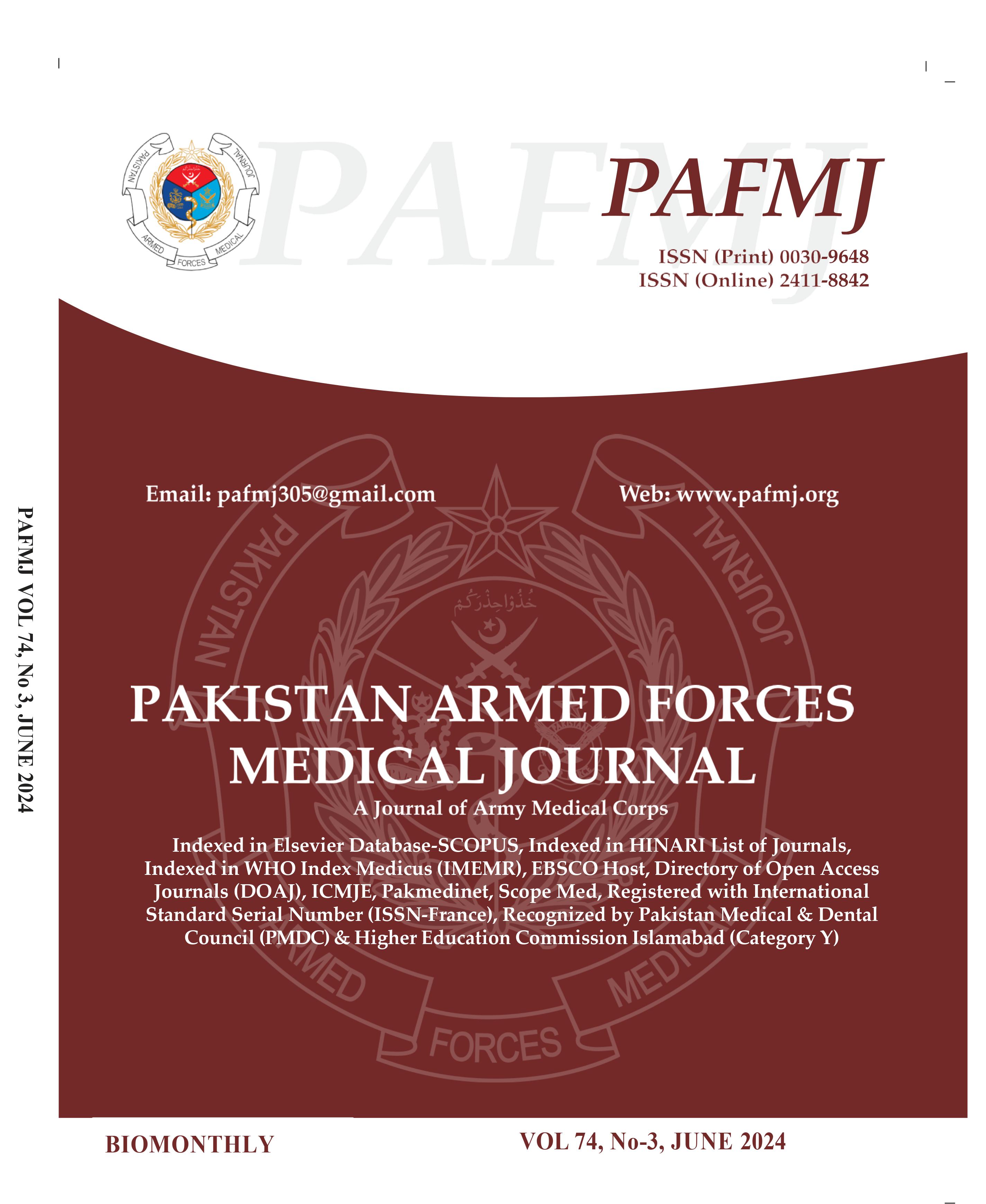Open Versus Closed Negative Pressure Wound Therapy For Contaminated and Dirty Surgical Wounds: A Quasi-Experimental Study
DOI:
https://doi.org/10.51253/pafmj.v74i3.8949Keywords:
Negative Pressure Wound Therapy, Surgical Wound, Wound HealingAbstract
Objectives: To determine the efficacy of open versus closed negative pressure wound therapy for contaminated and dirty surgical wounds in terms of time duration to full wound healing.
Study Design: Quasi-experimental study.
Place and Duration of Study: Department of General Surgery, Combined Military Hospital, Quetta Pakistan, from Oct 2021 to Apr 2022.
Methodology: A total of 96 patients with surgical wounds requiring repair were included for study. All patients underwent their respective surgery followed by grouping. Patients in Group-A received closed negative pressure wound therapy while those in Group-B received open negative pressure wound therapy. All patients were followed up till complete healing of the wound or till the occurrence of complications.
Results: Our study sample had a mean age of 44.16±12.66 years, with a slight female preponderance of 51(53.1%) participants. The mean total healing time for closed negative pressure wound therapy was 17.35±6.95 days, while it was 42.00±16.21 days with open negative pressure wound therapy, (p<0.001). There was no difference between the two groups with regards to the total complication rate, or the occurrence of individual complications, (p>0.05).
Conclusion: Closed negative pressure wound therapy results in faster wound healing, with a similar complication rate as open negative pressure wound therapy.
Downloads
References
Gillespie B, Harbeck E, Rattray M, Liang R, Walker R, Latimer S, et al. Worldwide incidence of surgical site infections in general surgical patients: A systematic review and meta-analysis of 488,594 patients. Int J Surg 2021; 95: 106136.
https://doi.org/10.1016/j.ijsu.2021.106136
Onyekwelu I, Yakkanti R, Protzer L, Pinkston CM, Tucker C, Seligson D. Surgical Wound Classification and Surgical Site Infections in the Orthopaedic Patient. J Am Acad Orthop Surg Glob Res Rev 2017; 1(3): e022.
https://doi.org/10.5435/JAAOSGlobal-D-17-00022
Ortega G, Rhee DS, Papandria DJ, Yang J, Ibrahim AM, Shore AD, et al. An evaluation of surgical site infections by wound classification system using the ACS-NSQIP. J Surg Res 2012; 174(1): 33-38.
https://doi.org/10.1016/j.jss.2011.05.056
Shah R, Pavey E, Ju M, Merkow R, Rajaram R, Wandling MW, et al. Evaluation of readmissions due to surgical site infections: A potential target for quality improvement. Am J Surg 2017; 214(5): 773-779.
https://doi.org/10.1016/j.amjsurg.2017.04.011
Sherrod BA, Rocque BG. Morbidity associated with 30-day surgical site infection following nonshunt pediatric neurosurgery. J Neurosurg Pediatr 2017; 19(4): 421-427.
https://doi.org/10.3171/2016.11.PEDS16455
Koek M, van der Kooi TII, Stigter F, de Boer P, de Gier B, Hopmans T, et al. Burden of SSI Study Group. Burden of surgical site infections in the Netherlands: cost analyses and disability-adjusted life years. J Hosp Infect 2019; 103(3): 293-302.
https://doi.org/10.1016/j.jhin.2019.07.010
Schimmel J, Belcher M, Vieira C, Lawrence N, Decker A. Incidence of Surgical Site Infections in Second Intention Healing After Dermatologic Surgery. Dermatol Surg 2020; 46(12): 1492-1497.
https://doi.org/10.1097/DSS.0000000000002409
Britto EJ, Nezwek TA, Robins M. Wound Dressings. StatPearls Publishing; 2022.
Zaver V, Kankanalu P. Negative Pressure Wound Therapy. StatPearls Publishing; 2022.
Stannard JP, Gabriel A, Lehner B. Use of negative pressure wound therapy over clean, closed surgical incisions. Int Wound J;9 Suppl 1(Suppl 1): 32-39.
https://doi.org/10.1111/j.1742-481X.2012.01017.x
Frazee R, Manning A, Abernathy S, Isbell C, Isbell T, Kurek S, et al. Open vs Closed Negative Pressure Wound Therapy for Contaminated and Dirty Surgical Wounds: A Prospective Randomized Comparison. J Am Coll Surg 2018; 226(4): 507-512. https://doi.org/10.1016/j.jamcollsurg.2017.12.008
Miller C. The History of Negative Pressure Wound Therapy (NPWT): From "Lip Service" to the Modern Vacuum System. J Am Coll Clin Wound Spec 2013; 4(3): 61-62.
https://doi.org/10.1016/j.jccw.2013.11.002
Lozano G, Ruiz A, Díaz JA, Gómez JA, Flores E. Surgical Site Infection Rate Drops to 0% Using a Vacuum-Assisted Closure in Contaminated/Dirty Infected Laparotomy Wounds. Am Surg 2017; 83(5): 512-514.
https://doi.org/10.1177/000313481708300528
Thomas M, Makey I, Buchanan M, Heckman M, White L, Lechtenberg B, et al. A Comparison of Negative Pressure and Conventional Therapy in Infected Open Chest Wounds. Surg Infect 2021; 22(9): 955-961. https://doi.org/10.1089/sur.2020.397
Sood A, Granick M, Tomaselli N. Wound Dressings and Comparative Effectiveness Data. Adv Wound Care 2014; 3(8): 511-529.
https://doi.org/10.1089/wound.2012.0401
Hasan MY, Teo R, Nather A. Negative-pressure wound therapy for management of diabetic foot wounds: a review of the mechanism of action, clinical applications, and recent developments. Diabetes Foot Ankle 2015; 6: 27618.
https://doi.org/10.3402/dfa.v6.27618
Iheozor Z, Newton K, Dumville JC, Costa ML, Norman G, Bruce J. Negative pressure wound therapy for open traumatic wounds. Cochrane Database Syst Rev 2018; 7(7): CD012522.
https://doi.org/10.1002/14651858.CD012522.pub2
O'Leary D, Peirce C, Anglim B, Burton M, Concannon E, Carter M, et al. Prophylactic Negative Pressure Dressing Use in Closed Laparotomy Wounds Following Abdominal Operations: A Randomized, Controlled, Open-label Trial: The P.I.C.O. Trial. Ann Surg 2017; 265(6): 1082-1086.
https://doi.org/10.1097/SLA.0000000000002098
Schurtz E, Differding J, Jacobson E, Maki C, Ahmeti M. Evaluation of negative pressure wound therapy to closed laparotomy incisions in acute care surgery. Am J Surg 2018; 215(1): 113-115.
https://doi.org/10.1016/j.amjsurg.2017.08.009
Sahebally S, McKevitt K, Stephens I, Fitzpatrick F, Deasy J, Burke JP, et al. Negative Pressure Wound Therapy for Closed Laparotomy Incisions in General and Colorectal Surgery: A Systematic Review and Meta-analysis. JAMA Surg 2018; 153(11): e183467.
https://doi.org/10.1001/jamasurg.2018.3467
Ingargiola MJ, Daniali LN, Lee ES. Does the application of incisional negative pressure therapy to high-risk wounds prevent surgical site complications? A systematic review. Eplasty 2013; 13: e49.
Shen P, Blackham A, Lewis S, Clark C, Howerton R, Mogal H, et al. Phase II Randomized Trial of Negative-Pressure Wound Therapy to Decrease Surgical Site Infection in Patients Undergoing Laparotomy for Gastrointestinal, Pancreatic, and Peritoneal Surface Malignancies. J Am Coll Surg 2017; 224(4): 726-737.
Downloads
Published
Issue
Section
License
Copyright (c) 2024 Saqib Hameed, Mubashir Hanif, Zaki Hussain Salamat, Sohail Ilyas, Omar Farooq, Shafqat Rehman

This work is licensed under a Creative Commons Attribution-NonCommercial 4.0 International License.















